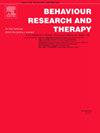Neuromodulation of heart rate and heart rate variability in a randomized controlled trial of tDCS-augmented in vivo exposure for specific fears
IF 4.2
2区 心理学
Q1 PSYCHOLOGY, CLINICAL
引用次数: 0
Abstract
This study evaluated the prediction that tDCS-augmented in vivo exposure (IVE) for specific fears would result in durable changes in heart rate (BPM) and heart-rate variability (HRV) during and just after exposure to feared targets. In a double-blind, placebo-controlled trial, participants with contamination- and animal phobia (N = 49) were randomized to active tDCS (1.7 mA, 20 min; n = 27), or sham tDCS (1.7 mA, 30 s; n = 22), followed by a single session of 30 min of IVE. Active tDCS targeted excitation of the left mPFC and inhibition of the right dlPFC. BPM and HRV were acquired during behavioral approach tasks involving brief (30 s) exposure to feared targets at pre-treatment, post-treatment, and a 1-month follow-up, as well as during six 5-min. trials of exposure. Active tDCS produced significantly greater reductions in BPM, and marginally greater increases in HRV from pre-treatment to 1-month in an extinction context, compared to sham tDCS. Similarly, active tDCS produced significantly greater reductions in BPM, and increases in HRV during IVE, relative to the sham tDCS group. Findings for the generalization context were non-significant. Consistent with the main outcome findings, tDCS may offer an effective means of enhancing outcomes in exposure therapy, perhaps through top-down modulation of autonomic arousal.
特定恐惧的tdcs增强体内暴露的随机对照试验中心率和心率变异性的神经调节
本研究评估了特定恐惧的tdcs增强体内暴露(IVE)在暴露于恐惧目标期间和之后会导致心率(BPM)和心率变异性(HRV)的持久变化的预测。在一项双盲安慰剂对照试验中,有污染和动物恐惧症的参与者(N = 49)被随机分配到活性tDCS组(1.7 mA, 20分钟;n = 27),或假tDCS (1.7 mA, 30 s;n = 22),然后进行单次30分钟的IVE。主动tDCS针对左侧mPFC的兴奋和右侧dlPFC的抑制。BPM和HRV是在行为方法任务中获得的,这些任务包括在治疗前、治疗后和1个月的随访中短暂(30秒)暴露于恐惧目标,以及6个5分钟。暴露试验。与假tDCS相比,从治疗前到1个月,在消失的情况下,活性tDCS显著降低了BPM,略微增加了HRV。同样,与假tDCS组相比,活跃tDCS组在IVE期间显著降低BPM,增加HRV。泛化背景的研究结果不显著。与主要的结果发现一致,tDCS可能通过自上而下的自主神经觉醒调节,为暴露疗法提供了一种有效的增强结果的手段。
本文章由计算机程序翻译,如有差异,请以英文原文为准。
求助全文
约1分钟内获得全文
求助全文
来源期刊

Behaviour Research and Therapy
PSYCHOLOGY, CLINICAL-
CiteScore
7.50
自引率
7.30%
发文量
148
期刊介绍:
The major focus of Behaviour Research and Therapy is an experimental psychopathology approach to understanding emotional and behavioral disorders and their prevention and treatment, using cognitive, behavioral, and psychophysiological (including neural) methods and models. This includes laboratory-based experimental studies with healthy, at risk and subclinical individuals that inform clinical application as well as studies with clinically severe samples. The following types of submissions are encouraged: theoretical reviews of mechanisms that contribute to psychopathology and that offer new treatment targets; tests of novel, mechanistically focused psychological interventions, especially ones that include theory-driven or experimentally-derived predictors, moderators and mediators; and innovations in dissemination and implementation of evidence-based practices into clinical practice in psychology and associated fields, especially those that target underlying mechanisms or focus on novel approaches to treatment delivery. In addition to traditional psychological disorders, the scope of the journal includes behavioural medicine (e.g., chronic pain). The journal will not consider manuscripts dealing primarily with measurement, psychometric analyses, and personality assessment.
 求助内容:
求助内容: 应助结果提醒方式:
应助结果提醒方式:


